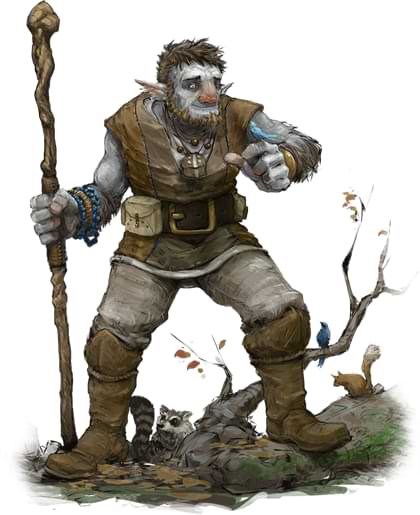Many species in Dungeons and Dragons feel like they've been lifted straight from a fairytale, and the firbolg is no different. The toe the line between sweetness and savagry, with an air of fey whimsy.
These firbolg were Viking inspired, giant warriors. They were the most powerful of all the minor giants with the ability to shrink down to human size and perform illusions in order to steal from unexpecting travellers. They were solitary and scheming, and fought with massive halberds and swords.
Volo's Guide to Monsters introduced the furry, red-nosed gentle giants to us in 5th edition. However they have been quite different in previous editions. Let's take a dive into the publication history of the firbolg!
 |
| Art is copyright Wizards of the Coast (1983–2009) |
These giantfolk were introduced in 1st edition Advanced Dungeons and Dragons in Monster Manual II (1983). Now, back in the day monsterous races were monsterous, elves and humans were the good guys and drow were incredibly problematic. If it wasn't a player race, it was there to slay in the pursuit of heroic glory. They would continue this monsterous career through to the Monstrous Compendium Vol. Two (1989).
It wouldn't be until years later in Monster Manual 2 (2002) that the Firbolg was made to be a playable race in 4th edition, and early on in 5th edition they were also included as a player race in Volo's Guide to Monsters.
Since
their days as giant Viking warriors there were tidbits of lore that had
creeped in over the years that changed the image of the firbolg to what
we know today. For example, they lived in nature due to distrusting
other races. Their illusionist abilities were stripped back to being
able to turn invisible. In 4th edition they were drastically altered.
They were now warriors of the feywild who toed the lines of
neutraility-- shamans and barbarians who commanded their forces in the
name of Nature deities.
Now in the days of 5th edition they may be fuzzier and rosey-cheeked, but the mysterious denizens of nature remain. Some of their illusionist magic has been returned to them, and they often use this to blend in with nature and life peaceful, solitary lives.
 | ||
| Wizards of the Coast. |
Obviously every character is different. Your firbolg may have hailed from the big city, or been raised by parents of another race-- but it is interesting to see how they have changed and diversified over the years.
If you haven't played a firbolg or want to see what the best builds are for these fuzzy giantkin, Wonder and Widget's Workshop on YoutTube has a conciese guide on getting started!
Will be sure to check this out! Love the Viking lore
ReplyDelete